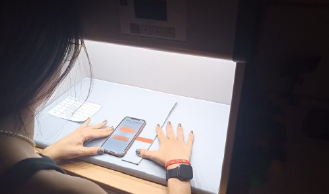
When visualizing colors on websites or in apps, color calibration is not feasible for consumer smartphones and tablets. The vast majority of consumers do not have the time, equipment or expertise to conduct color calibration. For such situations we recently developed the MDCIM (Mobile Display Characterization and Illumination Model) model. Using optics-based image processing it aims at improving digital color representation as assessed by human observers. It takes into account display-specific parameters and local lighting conditions. In previous publications we determined model parameters for four mobile displays: an OLED display in Samsung Galaxy S4, and 3 LCD displays: iPad Air 2 and the iPad models from 2017 and 2018. Here, we investigate the performance of another OLED display, the iPhone XS Max. Using a psychophysical experiment, we show that colors generated by the MDCIM method are visually perceived as a much better color match with physical samples than when the default method is used, which is based on sRGB space and the color management system implemented by the smartphone manufacturer. The percentage of reasonable to good color matches improves from 3.1% to 85.9% by using MDCIM method, while the percentage of incorrect color matches drops from 83.8% to 3.6%.
Eric Kirchner, Lan Njo, Esther Perales, Aurora Larrosa Navarro, Carmen Vázquez, Ivo van der Lans, Peter Spiers, "Improving Accuracy of Color Reproduction on Mobile Displays" in London Imaging Meeting, 2024, pp 116 - 119, https://doi.org/10.2352/lim.2024.5.1.24
 Find this author on Google Scholar
Find this author on Google Scholar Find this author on PubMed
Find this author on PubMed